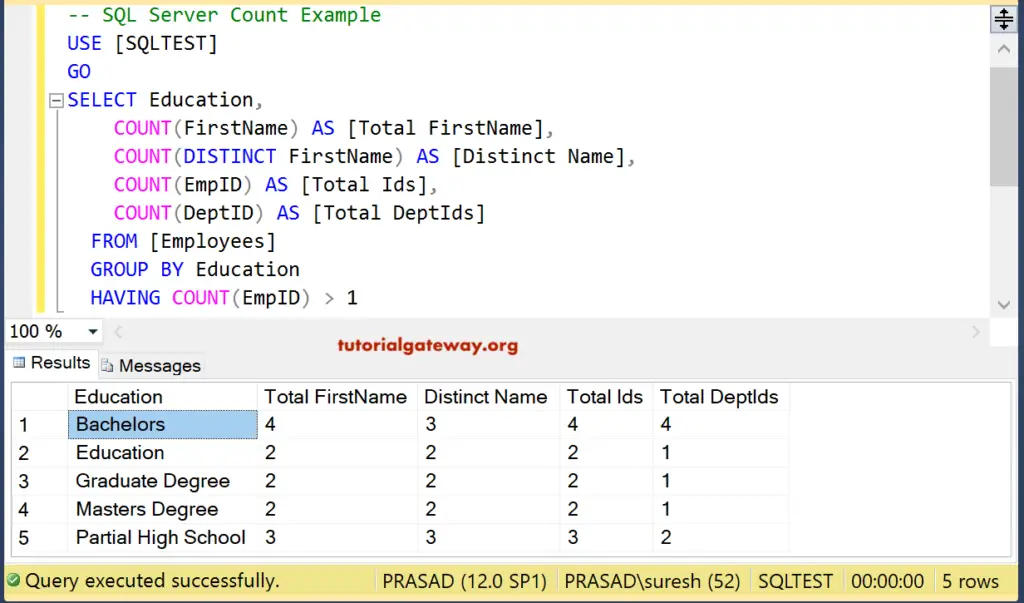
The HAVING clause with SQL COUNT () function can be used to set a condition with the select statement. The GROUP BY with HAVING clause retrieves the result for a specific group of a column, which matches the condition specified in the HAVING clause. La clausola HAVING Decisamente più interessante è il funzionamento di GROUP BY in congiunzione alla clausola HAVING la quale consente di impostare un filtro sui valori raggrupati.

Questa selezione restituisce lo stipendio, il numero di dipendententi e la spesa totale differenziata per ciascun valore di stipendio. HAVING filters records that work on summarized GROUP BY. Only the groups that meet the HAVING criteria will be returned. HAVING requires that a GROUP BY clause is present.
Anziché utilizzare la clausola HAVING, réservée pour les fonctions d’agrégation, à la place de la clause WHERE nell’istruzione SQL, è necessario usare la clausola HAVING, che è quella specifica per le funzioni di. WHERE and HAVING can be in the same query. If the HAVING clause contains a subquery, the subquery can refer to the outer query block if and only if it refers to a grouping column.
La condition HAVING en SQL est presque similaire à WHERE à la seule différence que HAVING permet de filtrer en utilisant des fonctions telles que SUM(), COUNT. The Oracle HAVING clause will filter the so that only departments with more than employees will be returned. HAVING is typically used with a GROUP BY clause.
Quando GROUP BY non viene usata, è presente un singolo gruppo aggregato implicito. When GROUP BY is not use there is an implicit single, aggregated group. Convenzioni della sintassi Transact-SQL Transact-SQL Syntax Conventions. In this page we are discussing the usage of SQL COUNT () along with the SQL MAX(). The sql having also be used with sql max function.

It was added to the SQL language because the WHERE keyword could not be used with aggregate functions. MySQL you could use the alias UniqueLocations in your having clause, but on many other systems the aliases are not yet available as the having clause is evaluated before the select clause, in this case you have to repeat the count on both clauses). And for the second one, there are many different ways to write that, this could.
For example, you can use the HAVING clause to answer questions like finding the number orders this month, this quarter, or this year that have total sales greater than 10K. In this tutorial, you have learned how to use the MySQL HAVING clause with the GROUP BY clause to specify filter conditions for groups of rows or aggregates. The RID built-in function and the ROW CHANGE expression cannot be specified in a HAVING clause unless they are within an aggregate function. Row access controls do not affect the operation of the HAVING clause.
Ok, quindi ci sono un paio di post qui già questo, e meno ancora sul web. Ho letteralmente provato ogni uno di loro e non può ottenere nulla per il lavoro. After GROUP BY combines records, HAVING displays any records grouped by the GROUP BY clause that satisfy the conditions of the HAVING clause. You could also use the SQL SUM function to return the name of the department and the total sales (in the associated department). Traduzioni in contesto per having to count in inglese-italiano da Reverso Context: Leave your apartment at the same time without having to count to 50.
Using Subqueries in the HAVING Clause. You can use sub queries in the HAVING clause to filter out groups of records. Just as the WHERE clause is used to filter rows of records, the HAVING clause is used to filter groups. Because of this, it becomes very useful in filtering on aggregate values such as averages, summations, and count.

With SQL queries you can combine the GROUP BY syntax with HAVING to return rows that match a certain count etc. This post looks at how to return rows based on a count using having specifically tested on MySQL but it should work for other database servers. How can I get a count for one column when specific criteria are met in other columns?
Here is what I have so far? Questo esempio usa COUNT con la clausola HAVING per restituire i reparti di una società, ognuno dei quali ha più di dipendenti. This example uses COUNT with the HAVING clause to return the departments of a company, each of which has more than employees. Per recuperare il numero delle voci distinte presenti in una tabella, le funzioni COUNT e DISTINCT possono essere utilizzate congiuntamente all’interno di un’unica istruzione.
SELECT DISTINCT(P.NAME),P.
Nessun commento:
Posta un commento
Nota. Solo i membri di questo blog possono postare un commento.